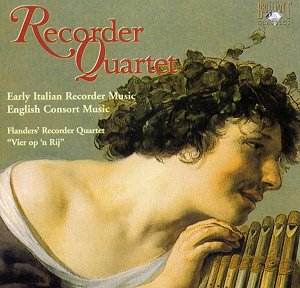Brilliant Classics
once again hit the mark with some rare
and delightful chamber music. This time
the selection mainly involves recorders
and the music is largely from the period
1550-1640. The set usefully allows comparison
of Italian and English renaissance styles.
The pieces are beautifully played and
happily the set comes with comprehensible
- in fact, ideal - programme notes.
The Italian pieces
are in a sense more interesting because
the recorder consort is mixed with a
consort of viols on some tracks and
sometimes a harpsichord acting as a
continuo as can be seen above, and therefore
there is more textural variety, but
the selection of English pieces shows
this country’s predilection at the time
for tunes accompanied by chords especially
in the music of Dowland as well as the
more severe polyphonic works, like the
several ‘Browning’ pieces which use
a popular melody of the time ‘The Leaves
be green’ as an excuse for complex variations.
William Byrd’s example, which opens
the second CD, is perhaps the most inspiring
and finest example. The other pieces
using this melody although attractive
never quite live up to it, with the
exception that is of a composer little
known and new to me, John Baldwin who
is represented by three pieces one a
fascinating didactic exercise in the
divisions of a minim into every possible
combination and often consecutively.
Another didactic piece
is the almost seven minute ‘Sit fast’
by Christopher Tye one of the earliest
composers of consort music, again this
divides the beat in even more complexity
and is a joy to hear played so brilliantly.
There are also a number
of In Nomine’s some by Tye. These free
pieces use a fragment of plainchant
from the ‘Missa Gloria tibi trinitas’
by the earlier English composer John
Tavener, around which complex counterpoint
is weaved. These may originally also
have been used by composer/teachers
as didactic exercises but then took
on a life of their own, dying out for
while before Purcell, as a teenager,
took up the form briefly as he learned
counterpoint himself.
The great John Dowland
is represented by a series of pieces
some being song arrangements and others
like the ‘Lacrimae Pavan’ scored originally
by Dowland for viol consort but here
played most successfully by recorders
alone. I was reminded in this sensitive
performance, again by the fineness of
his ‘Semper Dowland semper Dolens’ Pavan,
this motto being his own by-word. John
Ward’s ‘Fantasia’ represents a period
after the ‘In Nomine’ had died out,
indeed you could think here that you
were listening to an instrumental version
of a madrigal. The Fantasia by Richard
Deering leads us nicely into the Italian
music as he was apparently a pupil of
Gabrieli and even Monteverdi and his
music does have an unusually dramatic
character for a Renaissance English
man.
The Italian pieces
include an example of a Ricercar demonstrating
Palestrina’s polyphony which, especially
in the context of the later composers
Gabrieli, Castello and Merula for example,
seems perfect in its purity. Many of
these pieces use imitative counterpoint
as their starting point. Giovanni Picchi’s
attractive Canzon 19 is a lively imitative
piece with recorders and viols acting
as a double choir [with harpsichord
accompaniment] answering each other,
sometimes overlapping, then together
and each with a slightly differing musical
style. Typically it includes a section
in triple time with shorter antiphonal
phrases. More homophonic in style and
therefore more representative of the
early 17th century is Dario
Castello, especially his Sonata No 15.
The pieces recorded are mostly Sonata’s
and ‘Canzonas’ but Frescobaldi is represented
by a ‘Capriccio’. This, according to
the anonymous booklet notes, means music
of a "whimsical, fanciful character
with sudden contrasts and rubati’. Is
it the performance ? This does not come
across at all, there are some contrasts
certainly but it all seems rather serous
and the dynamics are rather unvaried.
I must say immediately
however that although the ‘Flanders’
Recorder Quartet was a new name to me
I am generally most impressed with the
whole CD. The tuning and musicianship
the choice of repertoire and varied
articulation, and the sense of ensemble
are most delightful and I will not criticize
any part of it except that lack of dynamics
contrast which I realize are not easy
to define on the recorder anyway sometimes
tires the ear especially in the English
music.
The recording is immediate
and although close has space also around
it. The notes on the music and composers
are helpful and very readable there
are some photos of the instruments [modern
copies] and performers and also some
biographies.
I recommend this disc
to everyone with an interest in Renaissance
music and/or early chamber music.
Gary Higginson







